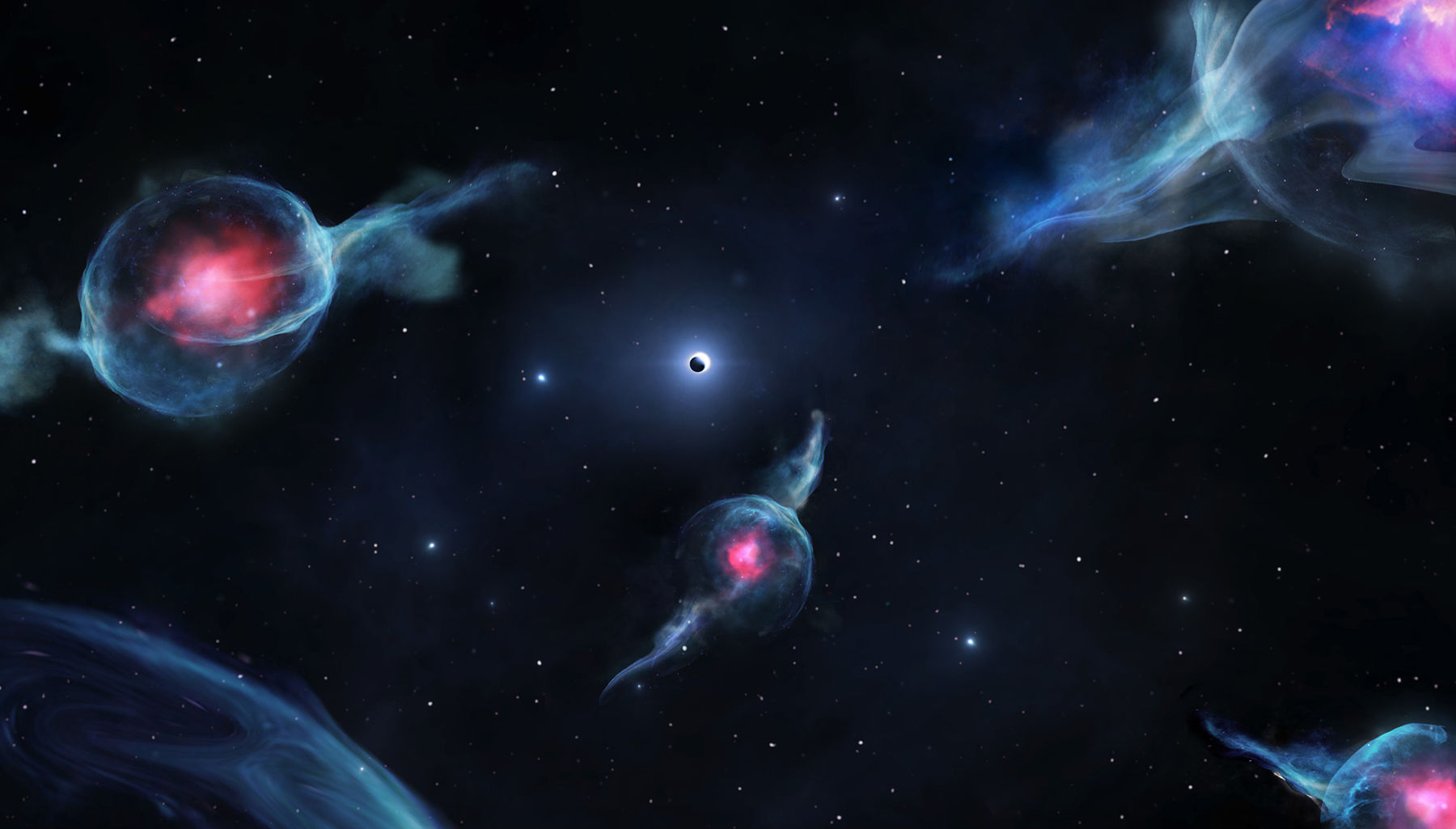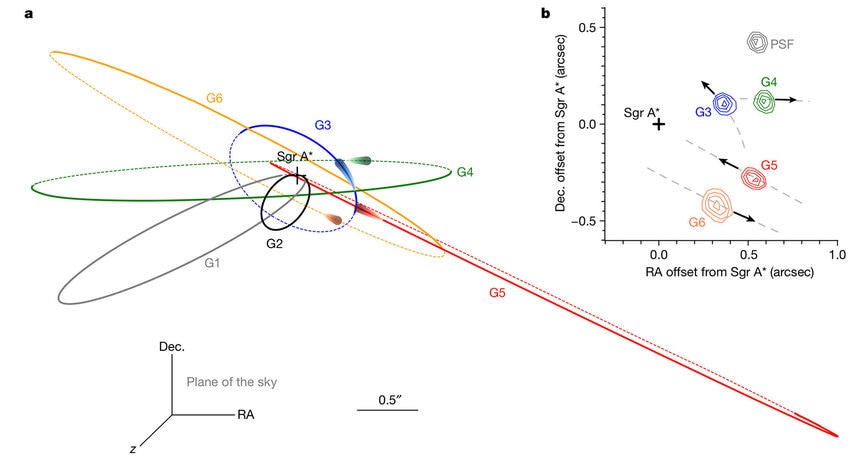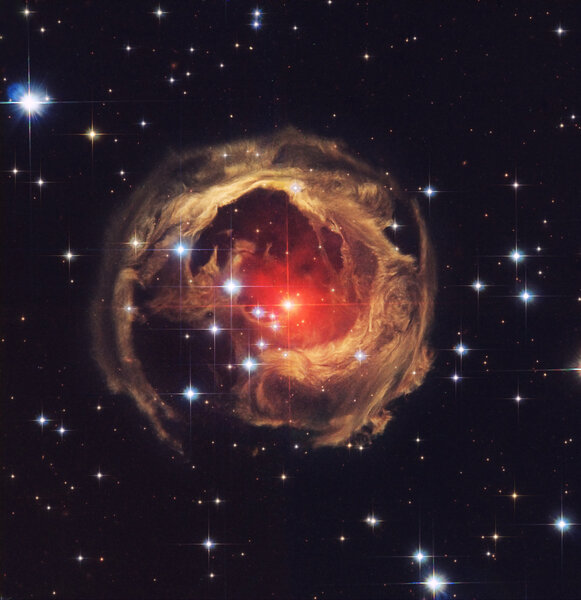Create a free profile to get unlimited access to exclusive videos, sweepstakes, and more!
Weird dust clouds orbiting our galaxy’s central black hole may be weirder than we thought

At the center of our Milky Way galaxy sits a supermassive black hole — which astronomers named Sgr A* — with over 4 million times the Sun's mass.
But it's not alone. Lots of other stuff is there, too, orbiting that black hole, including stars, gas, and dust. Over time, we can see these objects move, held sway by the incredible gravity of Sgr A*. In fact, the motions of several stars have told us a lot about the black hole itself.
But there is another class of objects there, something just recently discovered, and it's not clear what they are. If a team of astronomers is right, they could be among the more bizarre objects in the galaxy: Binary stars that, under the fierce influence of the black hole, have merged to become, something else. Single stars, but weird ones.
The first of these objects, called G1, was discovered in 2005, and the second (G2) in 2012. They looked like dust clouds, compact clumps of material. But in 2014, G2 passed very close to the black hole, close enough that were it a simple cloud it would've been shredded by the huge tidal force of the black hole. Shockingly, it survived intact! Astronomers then speculated that it may be a cloud of dust surrounding a star, and the gravity of the star kept the cloud from dispersing. But without more examples it was hard to know anything more.
And that's where the new research comes in. Using the massive Keck 10-meter infrared telescope in Hawaii, the astronomers found four more objects orbiting the supermassive black hole that look very much like the first two.
Like the first two, they appear to be dust clouds, emitting light characteristic of such things. They also appear to have hydrogen gas in them, which glows in the infrared at a specific wavelength (called Brackett gamma at about 2.2 microns, well outside what the human eye can see). They're on elliptical orbits around the black hole with periods ranging from 170 to 1,600 years, but the orbits are pretty different from each other (different ellipticities and orbit planes) indicating they didn’t all form from a single object like a dust cloud that got torn apart into littler ones. Interestingly, they've all remained about the same brightness over the 13 years of observations, so they appear to be somewhat stable.
So they can't be simple dust clouds, as we knew from the G2 close pass of the black hole. Then what are they?
The astronomers turned once again to the idea that each may once have been a binary star system, two stars orbiting each other closely. About half the stars in the galaxy are in binary systems like this, so they're very common. Usually, especially for low mass stars, they can orbit each like this for billions of years, happily swinging each other around their common center of gravity.
But ones close to the galactic center have a supermassive problem: Sgr A*. If they get too close to it in their orbit, the tides from the black hole can affect them. In a nutshell, gravity gets stronger the closer you are to an object, and if that object is a black hole that gradient can be steep. As they approach, one star is a little closer to the black hole than the other and gets pulled on much harder. This stretches the orbit due to that change in gravity. When they finally move away from Sgr A* their orbit around each other can be significantly modified.
If this happens again and again, the two stars can be dropped so close to each other that they merge, becoming a single star.
Mind you, this is a hugely energetic thing to have happen! We’re talking stars here. When they merge a lot of very powerful events occur, including the generation of a lot of dust: tiny grains of rocky or carbonaceous material. This dust expands around the star, forming a dense cloud around it.
That’s not just theory: We've seen it happen. The star V838 Monocerotis is an example of exactly this event. It's likely to be two massive stars that merged and blew out a huge cloud of dust. At some point in the recent past the star had an outburst of light, and as that pulse traveled through the cloud it illuminated different parts of it (it looks as if we’re watching the cloud expand, but in reality it's just the light moving through it that we see).
So are we seeing a half-dozen V838 Monocerotises* orbiting our galaxy's central supermassive black hole? It's certainly possible. The number we see fits, the idea that they are stars embedded in dense dust clouds fits, the dynamics fit (that is, getting binary stars around the black hole affected by its tides and merging is physically plausible), and we have an example of just such a beast (though not orbiting near the black hole; V838 is about 2,000 light years from us, while we’re 26,000 light years from the center of the galaxy). In fact, there was a recent burst of star formation in the galactic center about 4–6 million years ago, which very well could have been when these binaries were born.
So this is pretty convincing to me. I’ll note I liked this idea even before G3–6 were found, so I'm inclined to see this as more support. And if it turns out they're not recently merged binary stars eructating clouds of dust, well, then that means they're something even more bizarre.
I'm certainly OK with that. When you're talking supermassive black holes, all manners of weird stuff become commonplace. So whatever these things are, they're cool, and well worth keeping an (infrared) eye on.
*Pluralizing the genitive case of a Greek word in an English manner is well beyond my linguistic skills. So I'm going with that.

















